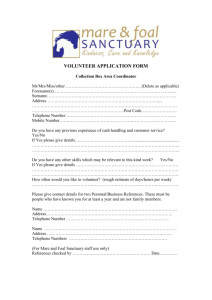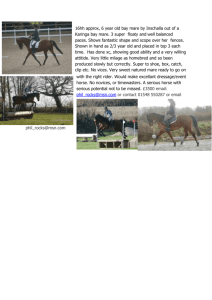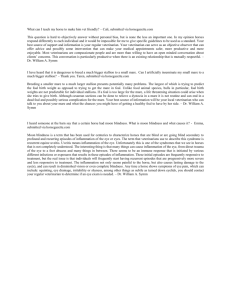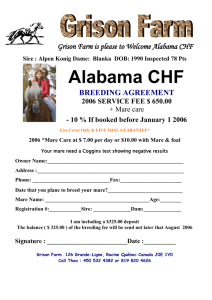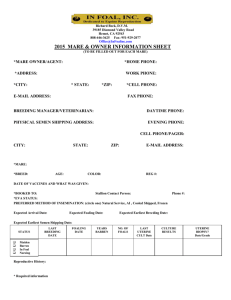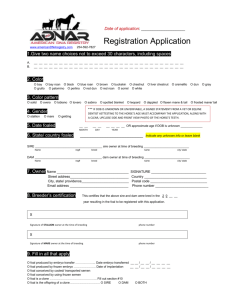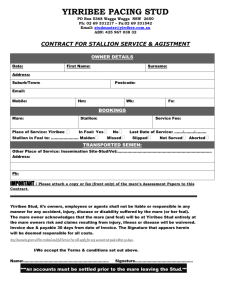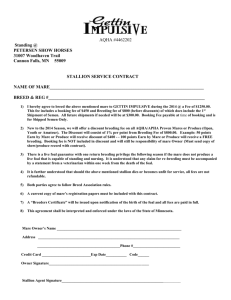A FEW THOUGHTS ON BREEDING
advertisement
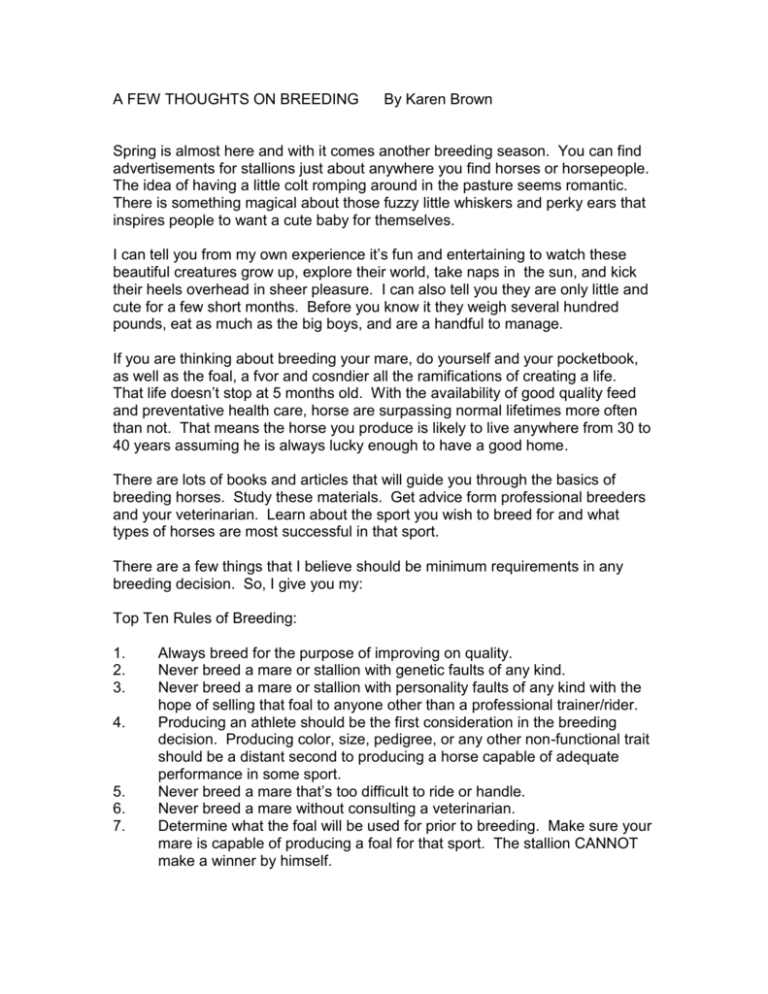
A FEW THOUGHTS ON BREEDING By Karen Brown Spring is almost here and with it comes another breeding season. You can find advertisements for stallions just about anywhere you find horses or horsepeople. The idea of having a little colt romping around in the pasture seems romantic. There is something magical about those fuzzy little whiskers and perky ears that inspires people to want a cute baby for themselves. I can tell you from my own experience it’s fun and entertaining to watch these beautiful creatures grow up, explore their world, take naps in the sun, and kick their heels overhead in sheer pleasure. I can also tell you they are only little and cute for a few short months. Before you know it they weigh several hundred pounds, eat as much as the big boys, and are a handful to manage. If you are thinking about breeding your mare, do yourself and your pocketbook, as well as the foal, a fvor and cosndier all the ramifications of creating a life. That life doesn’t stop at 5 months old. With the availability of good quality feed and preventative health care, horse are surpassing normal lifetimes more often than not. That means the horse you produce is likely to live anywhere from 30 to 40 years assuming he is always lucky enough to have a good home. There are lots of books and articles that will guide you through the basics of breeding horses. Study these materials. Get advice form professional breeders and your veterinarian. Learn about the sport you wish to breed for and what types of horses are most successful in that sport. There are a few things that I believe should be minimum requirements in any breeding decision. So, I give you my: Top Ten Rules of Breeding: 1. 2. 3. 4. 5. 6. 7. Always breed for the purpose of improving on quality. Never breed a mare or stallion with genetic faults of any kind. Never breed a mare or stallion with personality faults of any kind with the hope of selling that foal to anyone other than a professional trainer/rider. Producing an athlete should be the first consideration in the breeding decision. Producing color, size, pedigree, or any other non-functional trait should be a distant second to producing a horse capable of adequate performance in some sport. Never breed a mare that’s too difficult to ride or handle. Never breed a mare without consulting a veterinarian. Determine what the foal will be used for prior to breeding. Make sure your mare is capable of producing a foal for that sport. The stallion CANNOT make a winner by himself. 8. 9. 10. Seriously consider your facility’s qualifications as a nursery. A large turnout area is a must for a young horse to develop properly. Safe fencing and stabling is doubly important for young ones. Make a list of projected costs of breeding, raising, and training a horse. Be willing NOT to breed if you mare is not truly a candidate for motherhood. Briefly, let’s talk about each of these rules. First, you need to know if your mare is of sufficient quality in terms of conformation, movement, and temperament to be reproduced. Get opinions from professional breeders, (preferably ones with no financial stake in the evaluation), on your mare’s qualifications as a broodmare. It will take an expert in reproduction to accurately assess your mare; just because she is “a good horse” doesn’t mean she should reproduce. Thre are just as many mares that should be spayed as there are stallions that are, or should be, gelded. Number 2. It is impossible to improve on the species if we continue to breed horses with genetic faults. The fact that many champions have major faults is not an excuse to perpetuate the practice. Every champion that overcomes a defect has dozens of siblings that could not. Ignoring genetic faults in the breeding decision is good insurance that your foal will suffer from physical deterioration. Number 3. Any foal produced should be of a personality and temperament to be handled by amateurs. Professionals rarely buy horses; in any case they make a tiny percentage of the market. A horse that is too dominant, has a difficult nature, or is high strung or “hot” will not easily find a good home and will be a strong candidate for neglect and abuse. Number 4. Lots of horses are bred every year in the hope of producing a certain color, blanket, markings or body type. If the foal doesn’t have the desired trait, his only hope for a useful life to to have enough athletic ability to provide a function other than looking pretty. In respect to pedigrees, mutual fund companies say it best, “Past performance is no guarantee of future results”. Number 5. 100% of the foal’s environmental conditioning comes from the mare. If you mare is cranky, bossy, or temperamental, you foal will learn these traits from her. If she has rough gaits, the foal is likely to inherit her manner of traveling. If your mare is not a nice horse to ride or handle, don’t breed her. Disposition should be the number one factor in whether or not to breed your mare. A good temperament is critical to the success of selling the young horse. A horse that is difficult or a challenge is best left to professional riders and there aren’t enough of those around tomake a good market for your special foal. In order to have a chance at getting your foal a good home you must breed for the amateur owner. While precocious foals are very entertaining, the same foal can be a danger to unskilled handlers by the time they are just a few months old. Under saddle, that same horse will need a confident, bold, and skilled rider. Number 6. Have a veterinarian evaluate and examine your mare. You need to know if she is even capable of safely conceiving, carrying, and delivering a foal. Older mares have greater risks during pregnancy and maiden mares may have unknown abnormalities which may cause problems during pregnancy or birth. Before breeding your mare, a veterinarian should examine her reproductive system, evaluate her previous breeding history, and current physical condition. Number 7. 70% of the foal comes from the mare. Look at other foals your mare has produced to see what they are best suited for. What sport is your mare most talented in? Research stud prospects thoroughly to be sure his attributes will complement the mare’s. A quality stud can boost the quality of the foal, but he cannot completely overcome a poor choice of dam. Number 8. A natural setting with lots of room to frolic is essential for foals. The skeletal structure and soft tissue require the stresses from running and playing to reach full growth potential. Foals hve no experience with a man-made world and learn early lessons the hard way. Splintered wood, sagging fences or other potential hazards can inflict considerable damage on a young body. Horses with blemishes seldom make it to the show ring and young horses with old injuries are significantly devalued. Life-long behavioral problems can develop from lack of exercise and mental stimulation. Number 9. By the time you project all the costs involved with breeding, raising, nd training a horse to match your riding skill level, you may be shocked to find out how much money you have invested. You just might decide it’s more wise to locate a horse that suits your needs that is already of riding age and has the training you want. If you are not experienced in riding young stock, then saddle training fees will be much higher because you horse will be in training for severl months. Any trainer will tell you, there’s a big difference between riding older horses and young horses. By the time your young horse is ready for you, you’ll have several thousand dollars invested in making him a safe riding horse. And, even then, his education is just beginning. It takes YEARS of riding and exposure to the world for a horse to become solid and a joy to ride. If you plan to sell your foal for profit, research the market in your sport to see how much horses are selling for at different ages and levels of training to determine if it’s even possible to make money. Finally, but most importantly, after you have completed your research, if you conclude that your mare is truly not a candidate for motherhood, be responsible and don’t breed her. Choose another mare that is suitable or purchase a foal that meets your criteria. Breeding should be a practical decision, not an emotional, romantic notion. Do your homework then make a decision that is in the best interest of the foal. Copyright, 2007. Karen L. Brown
